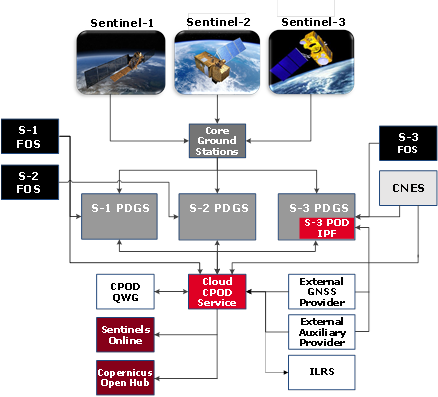The Copernicus POD (Precise Orbit Determination) Service is part of the Copernicus PDGS Ground Segment of the Sentinel missions and is in charge of the provision of Precise Orbital Products and auxiliary data files to the PDGS. The Copernicus POD Service was developed and is being operated by a GMV-led consortium from Tres Cantos, Spain. Additionally, for Sentinel-3 there is a POD Instrument Processing Facility in charge of generating the Near Real Time products running directly at the S-3 PDGS facilities.
This web page contains basic information describing the CPOD Service. Moreover, the CPOD Service regularly provides dynamic content for users who want to use the POD Orbital Products. This information can be found under the Technical Guides section.
The Copernicus POD Service interacts with many different entities, internal and external to the Copernicus program. The following is a description of the main elements involved in the Copernicus POD Service:
- GMV: leader of the consortium in charge of running the Copernicus POD Service. GMV is responsible for the proper function of the CPOD Service, including the generation and delivery of all precise orbital products and auxiliary date meeting accuracy and timeliness requirements, together with the coordination activities between the different elements that interact with the CPOD Service.
- Payload Data Ground Segment (PDGS): The PDGS is the main provider of inputs to the CPOD Service (GNSS measurements, attitude information, etc) and the unique recipient of the products generated.
- Sentinels Flight Operations Segment (FOS): Located at ESOC for Sentinel-1, Sentinel-2 and Sentinel-3 (for Sentinel-3 only during the commissioning phase) and EUMETSAT for Sentinel-3 during the routine operation phase, it is the provider of operational orbits, manoeuvre information and the satellite mass and centre of gravity evolution.
- External GNSS data Provider (EGP): A dedicated high accuracy and reliability external GPS data provider (VERIPOS). High rate orbits and clocks are provided with different levels of timeliness and accuracy. In case of unavailability a back-up solution has been put in place based on magicGNSS, a GMV solution for GNSS accurate products. IGS final orbits and clocks are also retrieved and used in the computation of the NTC products.
- International Laser Ranging Service (ILRS): They provide Sentinel-3 SLR data to be used in the POD processing, while the Copernicus POD provides orbit predictions (CPF files) of Sentinel-3 to ILRS.
- External Auxiliary providers: Earth Orientation Parameters and leap seconds from IERS (International Earth Rotation Service), solar and magnetic activity information for geodesy computations from NOAA and atmospheric gravity models from NASA.
- Centre National d'Études Spatiales (CNES): They provide Sentinel-3 orbital and attitude products (for comparison purposes), together with DORIS data. Copernicus POD provides GNSS Observation RINEX files to CNES.
- External Validation: A number of independent institutions (ESOC, DLR, TUM, AIUB and TU Delft) provide independent orbit solutions for validation purposes to assess the quality of the CPOD products. For Sentinel-3 other centres will provide orbital products, including CNES and EUMETSAT.
- CPOD Quality Working Group (CPOD QWG): The main purpose is to monitor the performance of the operational POD products (both the orbit products as well as the input tracking data) and to define potential and future enhancements to the orbit solutions.

Copernicus POD Service Elements and Interfaces